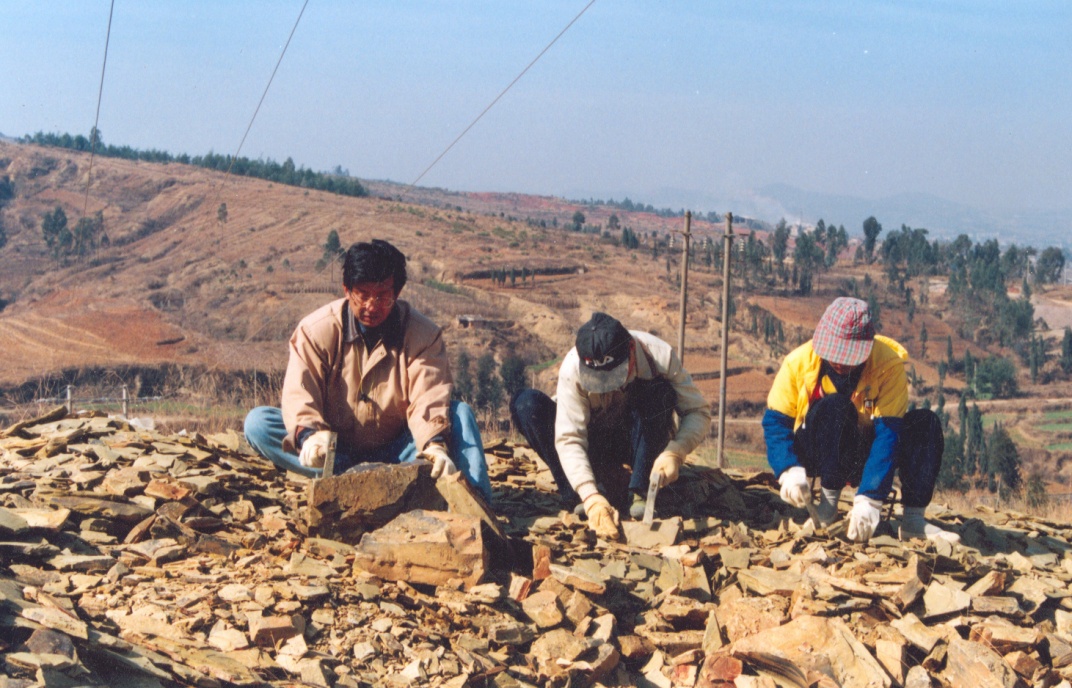
姓名:侯先光
职称:研究员
邮箱:xghou@ynu.edu.cn
电话:0871-65035365
地址:云南省昆明市翠湖北路2号,365体育官方唯一入口云南省古生物研究重点实验室
邮编:650091
个人简介
侯先光,男,汉族,江苏丰县人,九三学社社员,博士研究生,研究员,博士生导师,曾任365体育官方唯一入口学术委员会、学位委员会委员、国际古生物学会副主席, 澄江化石群的发现者。
1984年7月,经过长期艰苦、细致的野外工作,在云南省澄江县帽天山早寒武世地层内(5.2亿年前)发现了闻名于世的澄江化石群。该化石群的发现被世界科学界称为“二十世纪最惊人的发现之一”,世界科学家把该化石群评价为“永远是科学的大厦”,为早期生命科学研究开辟了一个重要的创新性研究领域。2009年10月,该发现被我国科学家遴选为新中国科技60周年60大科技成果之一。
发现澄江化石群后,每年在云南作了大量野外工作,进行了先期艰苦的开创性工作,开辟了一些澄江化石群新地点并作了详细的挖掘工作,极大地扩大了澄江化石群的分布范围,采集了数万块具有重要科学价值的保存软躯体化石标本。这些早期艰苦的工作,为全面、系统研究澄江化石群奠定了坚实基础。
作为发现者和早期艰苦工作的开辟者,对澄江化石群进行了全面、系统研究,描述发表了澄江动物化石群中绝大多数动物新属种,把发现该化石群所引起的国际轰动进一步提高到科学理论的认识水平。发表有关澄江化石群文章130余篇,在国外出版英文专著4部,中文专著1部,被SCI他人引用2000次以上,发表的澄江化石群的研究专著被外国专家在《Nature》、《Science》等十多家国际著名刊物上发表书评,向世界加以介绍和推荐,使澄江化石群在国际上产生了重大影响。
他的这一系列工作,使科学界对澄江化石群的科学意义、寒武纪生命大爆发有了一个较为全新和全面的认识,为全面揭示澄江化石群的科学意义和寒武纪生命大爆发特征做出了重要贡献。最古老的澄江化石群发现,对重新认识寒武纪生命大爆发和各动物门类的起源与演化理论有着极为重要意义。因此,2002年5月28日,江泽民总书记在“中国科学院第十一次院士大会和中国工程院第六次院士大会上的讲话”中,特别列举了云南澄江化石群的发现是我国基础科学研究领域中令人瞩目的重大成果之一。
由于云南澄江化石群的重要科学意义,带来了重大的社会影响和效益:
1、1992年2月,澄江化石群入选联合国教科文组织《全球地质遗迹遴选名录》中东亚优先甲等(A级);
2、1997年5月,澄江化石群首发地被云南省人民政府批准为省级自然保护区;
3、1998年11月,澄江化石群首发地被云南省委、省政府批准为云南省爱国主义教育基地;
4、2001年3月,澄江化石群首发地被国家首批为11个国家地质公园之一;
5、温家宝总理于2004年对澄江化石群的保护作了三次重要批示,9月5日的批示为“要保护澄江化石群,保护世界化石宝库,保护这个极具科学价值的自然遗产”;
6、2011年1月,“澄江化石地”被列入中国2011年上报联合国遗产中心的唯一世界自然遗产项目;
7、2012年7月,澄江化石群被成功列入“世界自然遗产名录” 。
学习和工作经历
1962.9–1968.7 徐州市第一中学初中、高中
1969.12–1973.8 江苏生产建设兵团如东棉场
1973.9–1977.2 南京大学地质系,学士
1977.2–1978.8 南京大学地质系,教师
1978.9–1981.9 中国科学院南京地质古生物研究所,硕士
1981.9–1990.9 中国科学院南京地质古生物研究所,实习研究员、助理研究员
1990.9–1998.8 瑞典国家自然博物馆,访问学者
1992.5–1997.5 瑞典乌普萨拉大学古生物系,理学博士(1994年晋升为研究员)
1995.6-1995.12 英国莱斯特大学地质系, 访问学者
1997.9–2000.9 中国科学院南京地质古生物研究所,研究员
2000.9–今 365体育官方唯一入口云南省古生物研究重点实验室,研究员
社会任职
1、前云南省古生物研究重点实验室主任
2、2006-2010年国际古生物学会副主席
3、前365体育官方唯一入口学术委员会委员、学位委员会委员
4、前《古生物学报》、《地层学杂志》编委
5、2006-2010年云南省第十届政协常委
6、2009-2019年云南省政府参事室参事
获奖及荣誉
1、1997,香港“求是”科技基金会“求是”奖集体奖
2、1997,中国科学院自然科学特等奖
3、1997,中国科学院有突出贡献的中青年专家荣誉称号
4、1998,南京十大科技成果奖
5、1999,国务院政府特殊津贴
6、2003,国家自然科学一等奖
7、2004,何梁何利基金科学与技术进步奖
8、2004,国家“五一”劳动奖章
9、2005,全国先进工作者荣誉称号
10、2005,云南省先进工作者荣誉称号
11、2006,首届兴滇人才奖
12、2008,国家引进国外智力贡献奖
13. 2011年云南省科学技术奖自然科学特等奖
14、2012年云南省科学技术奖杰出贡献奖
15、2017年中国九三学社“九三楷模”荣誉称号
近5年主要科研项目
1、 2008年1月—2011年12月,国家自然科学基金重点项目《早期节肢动物辐射及其环境研究》,批准号:40730211,经费160万元,主持。
2、 2014—2017年,国家自然科学基金-云南联合重点项目《澄江动物群演化意义及其相关环境研究》,批准号:U1302232,经费225万元,主持。
3、 2014—2017年,国家自然科学基金面上项目《澄江动物群节肢动物的演化》,批准号:41372031,经费80万元,主持。
专著
1. Hou Xianguang, Aldrige R.J., Bergström J., Siveter D.J., Siveter, D.J. & Feng Xianghong: The Cambrian Fossils of Chengjiang, China. The Flowering of Early Animal Life. Blackwell Publicatioin, 2004, Oxford.
2. Hou Xianguang, Siveter, D. J., Williams, M. & Feng Xianghong: A monograph of the Bradoriid arthropods from the Lower Cambrian of SW China. Transaction of the Royal Society of Edinburgh: Earth Sciences, Vol. 92, The Rcotland Foundation, 2002, Edinburgh, UK.
3. Hou Xianguang, Bergström, J.: Arthropods from the Lower Cambrian Chengjiang fauna, southwest China. Fossils and Strata, No. 45, Scandinavian University Press, 1997, Oslo, Norway.
4. 侯先光,扬.伯格斯琼,王海峰,冯向红,陈爱林: 澄江动物群 - 5.3亿年前的海洋动物,云南科技出版社, 1999, 昆明。
论文
1. Hou Xianguang, Williams M. , Gabbott S., Siveter D. J., Siveter D. J. , Cong Peiyun, Ma Xiaoya and Sansom R., 2016: A new species of the artiopodan arthropod Acanthomeridion from the lower Cambrian Chengjiang Lagerstätte, China, and the phylogenetic significance of the genus. Journal of Systematic Palaeontology (in press).
2. Hou Xianguang , Williams, M., Siveter, D. J., Siveter D. J., Gabbott, S., Holwell D. & Harvey T. H.P., 2014: A chancelloriid-like metazoan from the early Cambrian Chengjiang Lagerstätte, China. Scientific Reports 4:7340; DOI:10.1038/srep07340。
3. Hou Xianguang, R.J. Aldridge, D.J. Siveter, D.J. Siveter, M. Williams, J. Zalasiewicz & Ma Xiaoya, 2011: An early Cambrian hemichordate zooid. Current Biology, Vol. 21, 1–5.
4. Hou Xianguang, M. Williams, D. J. Siveter, D. J. Siveter, R. J. Aldridge and R. S. Sansom, 2010: phylogenetic relationships of Bradoriida Kunyangella and Kunmingella: significance for the Soft-part anatomy of the Early Cambrian bivalved arthropods. Proc. R. Soc. B 2010 277, 1835–1841.
5. Hou Xianguang, Siveter, D. J., Aldridge, R. J. and Siveter, D.J., 2009. A new arthropod in chain-like associations from the Chengjiang Lagerstätte (Lower Cambrian), Yunnan, China. Palaeontology, 52(4), 951–961.
6. Hou Xianguang, Clarkson, E. N. K., Yang Jie, Zhang Xiguang, Wu Guangqing, Yuan Zibo, 2009. Appendages of early Cambrian Eoredlichia (Trilobita) from the Chengjiang biota, Yunnan, China. Earth and Environmental Sciences Transaction of the Royal Society of Edinburgh, 99, 213–223.
7. Hou Xianguang, Siveter D.J., Aldrige R.J. & Siveter, D.J., 2008: Collective Behavior in an Early Cambrian Arthropod. Science, Vol. 322, 224.
8. Hou Xianguang, Bergström J.,Ma Xiaoya & Zhao Jie, 2006: The Lower Cambrian Phlogites Luo & Hu re-considered. GFF, Vol. 128, 47–51.
9. Hou Xianguang, Bergström J. & Yang Jie, 2006: Distinguishing anomalocaridids from arthropods and priapulids. Geological Journal, Vol. 41, 259–269.
10. Hou Xianguang, Stanley G.D., Zhao Jie & Ma Xiaoya, 2005: Cambrian anemones with preserved soft tissue from the Chengjiang biota, China. Lethaia, Vol. 38, 193–203.
11. Hou Xianguang, Bergström, J. & Xu Guanghui, 2004: The Lower Cambrian Crustacean Pectocaris from the Chengjiang Bioya, Yunnan, China. Journal of Paleontology, Vol. 78, 700–708.
12. Hou Xianguang, Ma Xioaya, Zhao Jie & Bergström, J. 2004: The lobopodian Paucipodian inermis from the Lower Cambrian Chengjiang fauna, Yunnan, China. Lethaia, Vol. 37, 235–244.
13. Hou Xianguang, Bergström, J. 2003: The Chengjiang fauna - the oldest preserved animal community. Paleontological Research, Vol.7, 55–70.
14. Hou Xianguang, Aldrige R.J., Siveter David J., Siveter, Derek J. & Feng Xianghong, 2002: New evidence on the anatomy and phylogeny of the earliest vertebrates. Proceedings of the Royal Society, B. 269, 1865–1869.
15. Hou Xianguang, 1999: New rare bivalved arthropods from the Lower Cambrian Chengjiang Fauna, Yunnan, China. Journal of Paleontology, Vol. 73, 102–116.
16. Hou Xianguang & Bergström, J. 1998: Three additional arthropods from the Early Cambrian Chengjiang Fauna, Yunnan, Southwest China. Acta Palaeontologica Sinica, Vol. 37, 395–405.
17. Hou Xianguang,1997: Lower Cambrian Arthropods from Southwest China. Bradoriids and Chengjiang arthropods. Ph.D. thesis, Uppsala University, Uppsala, Sweden.
18. Hou Xianguang, Siveter, D. J., Williams, M., Walossek, D. ? Bergström, J. 1996: Appendages of the arthropod Kunmingella from the early Cambrian of China: its bearing on the systematic position of the Bradoriida and the fossil record of the Ostracoda. Philosophical Transaction of the Royal Society of London, B 351, 1131–1145.
19. Hou Xianguang, Bergström J. 1995: Cambrian lobopodians - ancestors of extant onychophorans. Zoological Journal of the Linnean Society 114, 3–19.
20. Hou Xianguang, Bergström, J. & Ahlberg, P., 1995: Anomalocaris and other large animals in the Lower Cambrian Chengjiang fauna of southwest China, Geologiska Foreningens i Stockholm Forhandligar, Vol. 117, 163–183.
21. Hou Xianguang, Bergström, J. 1994: Palaeoscolecid worms may be nematomorphs rather than annelids. Lethaia 27, 11–17.
22. Hou Xianguang, Bergström, J. 1991: The arthropods of the Lower Cambrian Chengjiang fauna, with relationship and evlutionary significance. In A. M. Simonetta ? S. Conway Morris (eds.), The early evolutionary significance of problomatic taxa,, 179–187, Camerino, Cabridge Univercity Press, UK.
23. Hou Xianguang, Ramskold, L. ? Bergström, J. 1991: Composition and preservation of the Chengjiang fauna- a Lower Cambrian soft-bodied biota. Zoologica Scripta, Vol. 20, 395–411.
24. Hou Xianguang, 1987: Oldest Cambrian bradoriids from eastern Yunnan. Stratigraphy and Palaeontology of Systemic Boundaries in China, Precambrian and Cambrian Boundary, Vol. 1, 537–545, Nanjing Univercity Publishing House, Nanjing.
25. Hou Xianguang, 1989: Features and signficance of Chengjiang fauna: exceptionally preserved soft-bodied fauna from lowest Cambrian in Yunnan, China. 28th International geological Congress (Washington,D.C), Abstract 2, 75.
26. Aldridge R. J., Hou Xianguang, Siveter David J., Siveter Derek J. & Gabbott S., 2007: Systematic and Phylogenetic Relationships of Vetulicolians. Paleontology, Vol. 50, 131–168.
27. Bergström, J. & Hou Xianguang, 1998: Chengjiang Arthropods and Their Bearing on Early Arthropod Evolution. In G. D. Edgecombe (ed.), Arthropod Fossils and Phylogeny. Chichester, West Sussex, 151–184, New York.
28. Bergström, J. & Hou Xianguang, 2001: Cambrian Onychophora or Xenusians. Zoologischer Anzeiger, Vol. 240, 237–245.
29. Bergström, J. & Hou Xianguang, 2003: Cambrian arthropods: a lesson in convergent evolution. In Legakis A., Sfenthourakis S., Polymeni R. & Thessalou-Legaki M. (eds): The New Panorama of Animal Evolution, Pensoft Publishers, Sofia, 89–96, Moscow.
30. Bergström, J. & Hou Xianguang, 2003: Arthropod origin. Bulletin of Geosciences, Vol. 78, 323–334.
31. Bergström J. & Hou Xianguang, 2005: Early Palaeozoic non-lamellipendian arthropods. In Koenemann S. & Jenner R.A. (eds): Crustacea and Arthropod Ralationships, P. 73–93. Taylor & Francis.
32. Bergström J.,Hou Xianguang & Ulf Hålenius, 2007: Gut contents and feeding in the Cambrian arthropod Naraoia. GFF, Vol. 129, 71–76.
33. Bengtson S. & Hou Xianguang, 2001: The skin of Cambrian chancelloriids. Acta Palaeontologica Polonica, Vol. 46, 1–22.
34. Chen Junyuan, Bergström, J., Lindstrom, M., Hou Xianguang, 1991: Fossilized soft-bodied fauna. National Geogrophic Research Exploration, Vol. 7, 8–19.
35. Chen Junyuan, Hou Xianguang & Erdtmann. B. D., 1989: New soft-bodied fossil fauna near the base of the Cambrian System at Chengjiang, eastern Yunnan, China. Chinese Academy of Sciences, Developments in Geoscience, Contribution to 28th International Geological Congress, Washington D.C. USA, 265–278. Science Press, Beijing.
36. Cong Peiyun, Ma Xiaoya, Hou Xianguang, Edgecombe, G. D. & Strausfeld, N. J., 2014: Brain Structure Resolves the Segmental Affinity of Anomalocaridid Appendages. Nature, Vol. 513, 538-542.
37. Cong Peiyun, Hou Xianguang, Aldridge, R. J., Purnell, M. A. & Li Yizhen, 2014: New data on the palaeobiology of the enigmatic yunnanozoans from the Chengjiang Biota, Lower Cambrian, China. Palaeontology, 1-26. doi:10.1111/pala.12117
38. Cong Peiyun, Ma Xiaoya, Hou Xianguang, Edgecombe, G. D. & Strausfeld, N. J., 2014: Cong et al. reply,REPLYING TO G. Mayer, C. Martin, I. S. Oliveira, F. A. Franke & V. Gross Nature 516,E1-E2, Nature 516, E3_E4.
39. Gabbott S. E., Hou Xianguang, Norry M. J. & Siveter D. J. 2004: Preservation of Early Cambrian animals of the Chengjiang biota. Geology, Vol. 32, 901–904.
40. Jin Yugan,Hou Xianguang & Wang Huayu, 1993: Lower Cambrian pediculate lingulids from Yunnan, China. Journal of Paleontology, Vol. 67, 188–198.
41. Liu Yu, Hou Xianguang & Bergström, J., 2007: Chengjiang arthropod Leanchoilia illecebrusa (Hou, 1987) reconsidered. GFF, Vol. 129, 263–272.
42. Liu Yu, Haug J. T., Haug C., Briggs D. E.G. & Hou Xianguang, 2014: A 520 million-year-old chelicerate larva. Nat. Commun. 5:4440 doi: 10.1038/ncomms5440.
43. Liu Yu, Gerhard Scholtz & Hou Xianguang, 2015:. When a 520 million-year-old Chengjiang fossil meets a modern micro-CT – a case study. Scientific Reports 5, 12802; doi: 10.1038/srep12802.
44. Liu Yu, Melze R.R., Haug J.T., Haug C., Briggs D.E.G.., Hornig M., He Yuyang & Hou Xianguang, 2016: Three dimensionally preserved minute larva of a great appendage arthropod from the Early Cambrian Chengjiang biota. PNAS (in Press)
45. Ma Xiaoya, Hou Xianguang, Bergström J., 2009. Morphology of Luolishania longicruris (Lower Cambrian, Chengjiang Lagerstätte, SW China) and the phylogenetic relationships within lobopodians. Arthropod Structure & Development, 38, 271–291.
46. Ma XiaoYa, Hou XianGuang, David Baines, 2010:Phylogeny and Evolutionary Significance of the Vermiform Animals from the Early Cambrian Chengjiang Lagerstätte。Science China: Earth Sciences,Vol.53(12),1774–1783.
47. Ma Xiaoya, Hou Xianguang, Gregory D. Edgecombe& Nicholas J. Strausfeld, 2012:Complex brain and optic lobes in an early Cambrian arthropod, Nature, Vol.490, 258-261.
48. Ma Xiaoya, Hou Xianguang, Richard J. Aldridge , David J. Siveter , Derek J. Siveter, Sarah E. Gabbott , Mark A. Purnell, Andrew R. Parker, Gregory D. Edgecombe, 2012: Morphology of Cambrian lobopodian eyes from the Chengjiang Lagerstätte and their evolutionary significance, Arthropod Structure & Development, 41, 495-504.
49. Ma Xiaoya, Edgecombe G. D., Legg D. A. & Hou Xianguang, 2013: The morphology and phylogenetic position of the Cambrian lobopodian Diania cactiformis. Journal of Systematic Palaeontology, 29 May 2013 (On line).
50. Ma Xiaoya, Cong Peiyun, Hou Xianguang, Edgecombe G. D. & Strausfeld, N. J., 2014: An exceptionally preserved arthropod cardiovascular system from the early Cambrian. Nat. Commun. 5:3560 doi: 10.1038/ncomms4560.
51. Ma Xiaoya, Aldridge, R. J., Siveter, D.J., Siveter, D.J., Hou Xianguang & Edgecombe, G. D., 2014: A new exceptionally preserved Cambrian priapulid from the Chengjiang Lagerstätte. Journal of Paleontology, Vol. 88(2), p. 371-384.
52. Ma Xiaoya, Edgecombe G. D., Hou Xianguang, Goral, T., Strausfeld, N. J., 2015. Preservational Pathways of Corresponding Brains of a Cambrian Euarthropod. Current Biology, 25(22): 2969–2975.
53. Monge-Nájera J. & Hou Xianguang, 1999: 500 Millones de Aňos de Evolución: Onicóforos, los Primeros Animales due Caminaron (Onychophora). Evolución y Filogenia de Arthropoda. Bol. S. E. A., No. 26, 171–176.
54. Monge-Nájera J. & Hou Xianguang, 2000: Disparity, decimation and the Cambrian “explosion”: comparison of early Cambrian and Present faunal communities with emphasis on velvet worms (Onychophora). Revista de Biologia Tropical, Vol. 48(2000), 333–351.
55. Nicholas Strausfeld, Ma Xiaoya, Gregory D Edgecombe, Richard A Fortey, Michael F Land, Liu Yu, Cong Peiyun & Hou Xianguang, 2015: Arthropod Eyes: The Early Cambrian Fossil Record and Divergent Evolution of Visual Systems. Arthropod Structure & Development.
56. Ramskold, L. Hou Xianguang, 1991: New early Cambrian animal and onychophoran affinities of enigmatic metazoans. Nature 351, 225–228.
57. Rigby, J. K. Hou Xianguang, 1995: Lower Cambrian demosponges and hecactinellid sponges from Yunnan, China. Journal of Paleonlogy, Vol. 69, 1009–1019.
58. Robert R. Gaines, Emma U. Hammarlund, Hou Xianguang, Qi Changshi, Sarah E. Gabbottf, ZhaoYuanlong Peng Jin, and Donald E. Canfieldb, 2012: Mechanism for Burgess Shale-type preservation. PNAS . vol. 109 no. 14 .5180–5184.
59. Strausfeld Nicholas, Ma Xiaoya, Gregory D Edgecombe, Richard A Fortey, Michael F Land, Yu Liu, Cong Peiyun & Hou Xianguang, 2015: Arthropod Eyes: The Early Cambrian Fossil Record and Divergent Evolution of Visual Systems. Arthropod Structure & Development.
60. Tanaka G., Hou Xianguang, Ma Xiaoya, Edgecombe G.D., Strausfeld N.J., 2013: Chelicerate Neural ground pattern in a Cambrian ‘great appendage’ arthropod. Nature,Vol. 502, p. 364-367.
61. Yang Xianfeng, Olev Vinn, Hou Xianguang & Tian Xinglei,2013: New tubicolous problematic fossil with some “lophophorate” affinities from the Early Cambrian Chengjiang Biota in South China. GFF, Vol. 135(2), p. 184-190.
62. Zhang Xiguang, Hou Xianguang & Christian C. E., 2003: Evidence of lophophore diversity in Early Cambrian Brachiopoda. Proc. R. Soc. Lond B 270, 65–68.
63. Zhang Xiguang & Hou Xianguang, 2004: Evidence for a single median fin-fold and tail in the Lower Cambrian vertebrate, Haikouichthys ercaicunensis. J. Evol. Biol. Vol. 17, 1162–1166.
64. Zhang Xiguang, Hou Xianguang & Bergström, J., 2006: Early Cambrian priapulid worms buried with their lined burrows. Geological Magazine, Vol. 143, 743–748.
65. Zhang Xiguang & Hou Xianguang, 2007: Gravitational Constraints on the Burial of the Chengjiang Fossils. Palaios, Vol. 22, 448–453.
66. Zhang Xiguang, Bergström J., Bromley R.G.. & Hou Xianguang, 2007: Diminutive trace fossils in the Chengjiang Lagerstätte. Terra Nova, Vol. 19, 407–412.
67. 侯先光,1987a. 云南澄江早寒武世两个保存附肢的节肢动物。古生物学报,26卷,236–256页。
68. 侯先光,1987b. 云南澄江早寒武世三个新的大型节肢动物。古生物学报,26卷,272–285页。
69. 侯先光,1987c. 云南澄江早寒武世大型双瓣壳节肢动物。古生物学报,26卷,286–298页。
70. 侯先光,2001. 生命演化的大霹雳 - 澄江生物群与后生动物的崛起。科学月刊,32卷,530–539页。
71. 侯先光,2002. 云南澄江生物群。陈毓川主编,中国地质学会80周年学术文集,地质出版社, 54–61页,北京。
72. 侯先光、孙卫国,1988. 澄江动物群在云南晋宁梅树村的发现。古生物学报,27卷,1–12页。
73. 侯先光、陈均远,1989a. 云南澄江早寒武世带触手的蠕形动物 - Facivermis gen. nov.。古生物学报,28卷, 32–41页。
74. 侯先光、陈均远,1989b. 云南澄江早寒武世节肢类与环节类中间性生物 - Luolishania gen. nov.。古生物学报,28卷, 207–113页。
75. 侯先光、陈均远、路浩之,1989. 云南澄江早寒武世节肢动物。古生物学报,28卷, 42–57页。
76. 侯先光,陈爱林,1999. 生命的演化进程。云南科技出版社,28–76页,昆明。
77. 侯先光, Bergström J., 2006. 恐虾动物是异常节肢动物还是似节肢动物的蠕形动物? 戎嘉余主编,生物的起源、辐射、与多样性演化 – 华夏化石记录的启示。科学出版社, 139–158页(中文), 847–850 (英文),北京。
78. 侯先光、冯向红,1999:澄江生物化石群。生物学通报,34卷12期,6–8页。
79. 侯先光、杨杰,2008. 远古海洋生态群落图。大自然探索,1月号,15–21页。
80. 侯先光,丛培允,李宜真,2009:云南虫的埋藏学研究—兼论云南虫的分类位置。古生物学报,48(3),402–413。
81. 孙卫国、侯先光,1987a. 云南澄江早寒武世水母化石。古生物学报,26卷, 257–271页。
82. 孙卫国、侯先光,1987b. 云南澄江早寒武世蠕虫化石 - Maotianshania gen. nov. 古生物学报,26卷, 257–271页。
83. 陈均远、侯先光、路浩之,1989a. 早寒武世带网状鳞片的蠕形海生动物。古生物学报,28卷, 1–16页。
84. 陈均远、侯先光、路浩之, 1989b. 云南澄江下寒武统细丝海绵化石。古生物学报,28卷, 17–31页。
85. 陈均远、侯先光、路浩之,1989c. 早寒武世高足杯状稀珍海生动物 - Dinomischus (Entoprocta) 及其生态模式。古生物学报,28卷, 58–71页。
86. 陈均远、侯先光、李国详,1990. 云南澄江下寒武统海绵化石新属 - Quadrolaminiella gen. Nov.。古生物学报,29卷, 402–414页。
87. 杨杰,侯先光,董渭,2008. 昆明地区下寒武统节肢动物Guangweicaris Luo, Fu et Hu, 2007的再研究。古生物学报,47卷,115–122页。
88. 杨杰, 侯先光, 丛培允, 董渭, 张艳霞, 罗茂斌, 2010: 昆明地区下寒武统沧浪铺组古虫动物新发现,古生物学报, 49卷1期,54–63。
89. 张文堂、侯先光, 1985. Naraoia在亚洲大陆的发现。古生物学报,24卷,591–595页。
会议摘要
1. Hou Xianguang, Clarkson, E. N. K., Yang Jie, Zhang Xiguang, Wu Guangqing & Yuan Zibo, 2009: Appendages of early Cambrian Eoredlichia (Trilobita) from the Chengjiang biota, Yunnan, China. In Smith M., O’Brien L. & Caron J., International Conference on the Cambrian Explosion, Abstract volume, 77.
2. Hou Xianguang, Clarkson, E. N. K., Yang Jie, Zhang Xiguang, Wu Guangqing & Yuan Zibo, 2009: Appendages of early Cambrian Eoredlichia (Trilobita) from the Chengjiang biota, Yunnan, China. In Smith M., O’Brien L. & Caron J., International Conference on the Cambrian Explosion, Abstract volume, 77.
3. Hou Xianguang, Arthropods of the Chengjiang fauna, 1989, The early evolution of Metazoa and the significance of problematic taxa, Camerino University, Italy.
4. Hou Xianguang, 1993. The arthropod Naraoia from the Lower Cambrian Chengjiang Fauna, The Annual Meeting of Palaeontological Association of Sweden, Lund University, Lund, Sweden.
5. Hou Xianguang & Bergström, J., 1995. The Chengjiang Fauna: A clear window to Early Metazoan Structure,International Cambrian Explosion Symposium, Nanjing.
6. Hou Xianguang, Bergström, J. & Ahlberg. P. 1995. Anomalocaridids from the Lower Cambrian Chengjiang Fauna of southwest China, International Cambrian Explosion Symposium, Nanjing.
7. Hou Xianguang, Earthshaking Discovery, Human Treasure, 2001, An International Symposium on exploring the history of life on the earth: Paleontology in China during the last 15 years, Beijing.
8. Hou Xianguang, 2001. The Earky Cambrian Chengjiang Fauna in Yunnan, China: the Oldest Animals on Earth, The 17th International Symposium in Conjunction with Award of the International Prize for Biology: The Origin and Early Evolution of Metazoa. Kyoto University,Japan
9. Stanley G. D., Haddock S. H. D., Hou Xianguang & Chen Ailin, 2009: Soft-bodied gelatinous fossils (Cnidaria/Ctenophora) from the Lower Cambrian, Chengjiang biota, Yunnan Province, China. In Smith M., O’Brien L. & Caron J., International Conference on the Cambrian Explosion, Abstract volume, 57–58.
10. Cong Peiyun, Hou Xianguang, Li Yizhen and Yang Jie, 2010. The segmentation of yunnanozoans. The Third International Palaeontological Congress (Abstract volume). 71.
11. Ma Xiaoya, Hou Xianguang, Aldridge, Richard, Siveter, David and Siveter, Derek,2010. Evidence of Possible Parasitic Worms from the Lower Cambrian Chengjiang Lagerstäte. The Third International Palaeontological Congress (Abstract volume). 257.
12. Cong Peiyun & Hou Xianguang, 2009: A New anomalocaridid from the Chengjiang biota. In Smith M., O’Brien L. & Caron J., International Conference on the Cambrian Explosion, Abstract volume, 26–27.
13. Gaines R. R., Hammarlund E., Canfield D. E., Hou Xianguang & Gabbott S. E., 2009: Evidence for the mechanism of Burgess Shale-type preservation from the Chengjiang scientific drilling project. In Smith M., O’Brien L. & Caron J., International Conference on the Cambrian Explosion, Abstract volume, 31–32.
14. Hammarlund E., Gaines R. R., Canfield D. E., Hou Xianguang & Bengtson S., 2009: Water column chemistry at Chengjiang. In Smith M., O’Brien L. & Caron J., International Conference on the Cambrian Explosion, Abstract volume, 34–35.
15. Yang Xianfeng & Hou Xianguang, 2009: The oldest known example of trilobite ecdysis (Chengjiang biota, Early Cambrian). In Smith M., O’Brien L. & Caron J., International Conference on the Cambrian Explosion, Abstract,volume, 96–97.
16. 侯先光,1999. 澄江动物群 - 5.3亿年前的动物世界, 中国科协首届学术年会, 杭州。
17. 侯先光,2002. 云南澄江生物群,中国地质学会80周年学术讨论会,北京。
18. 侯先光, 2009:澄江动物群的节肢动物。中国古生物学会第十次全国代表大会暨第25届学术年会,纪念中国古生物学会成立80周年,论文摘要集,25–26页。中国古生物学会。
19. 丛培允,侯先光,2009:澄江生物群奇虾动物的分异度。中国古生物学会第十次全国代表大会暨第25届学术年会,纪念中国古生物学会成立80周年,论文摘要集,26页。中国古生物学会。
20. 杨显峰,侯先光,2009:早古生代澄江动物群后生动物的视觉系统。中国古生物学会第十次全国代表大会暨第25届学术年会,纪念中国古生物学会成立80周年,论文摘要集,26–27页。中国古生物学会。
21. 李宜真,丛培允,侯先光,2009:云南虫鳃的形态学比较。中国古生物学会第十次全国代表大会暨第25届学术年会,纪念中国古生物学会成立80周年,论文摘要集,28–29页。中国古生物学会。
指导学生
硕士研究生
1. 徐光辉, 男,硕士研究生,1999-2002年,寒武纪早期生命
2. 马晓娅,女,硕士研究生,2002-2005年,寒武纪早期生命
3. 刘煜,男,硕士研究生,2003-2006年,寒武纪早期生命
4. 袁自波,男,硕士研究生,2004-2007年,寒武纪早期生命
5. 胡绳,男,硕士研究生,2005-2008年,寒武纪早期生命
6. 余笋,女,硕士研究生,2006-2009年,寒武纪早期生命
7. 张艳霞,女,硕士研究生,2006-2009年,寒武纪早期生命
8. 郭进,男,硕士研究生,2007-2010年,寒武纪早期生命
9. 李宜真,男,硕士研究生,2008-2011年,寒武纪早期生命
10. 田兴磊,男,硕士研究生,2009-2012年,寒武纪早期生命
11. 李昱静,女,硕士研究生,2010-2013年,寒武纪早期生命
12. 孙轲,男,硕士研究生,2011-2014年,寒武纪早期生命
13. 张连祥,男,硕士研究生,2011-2014年,寒武纪早期生命
14. 赵军,男,硕士研究生,2012-2015年,寒武纪早期生命
15. 杜成航(与Liston博士和王李花博士合招),男,硕士研究生,2013-2016年,脊椎动物化石
16. 陈笑寒,男,硕士研究生,2013-2016年,寒武纪早期生命
17. 吴迪,男,硕士研究生,2014-2017年,寒武纪早期生命
18. 赵婷,女,硕士研究生,2015-xxxx年,寒武纪早期生命
博士研究生
1. 陈爱林,男,博士研究生(在职),2009-2015年,澄江动物群中海绵化石
2. 何雨洋,女,博士研究生(在职),2012-2018年,澄江动物群中节肢动物
3. 李昱静,女,博士研究生,2013-2018年,澄江动物群中疑难化石
4. 陈红,女,博士研究生(在职),2015-xxxx年,寒武纪早期生命
5. 陈笑寒,男,博士研究生,2016-xxxx年,澄江动物群中节肢动物
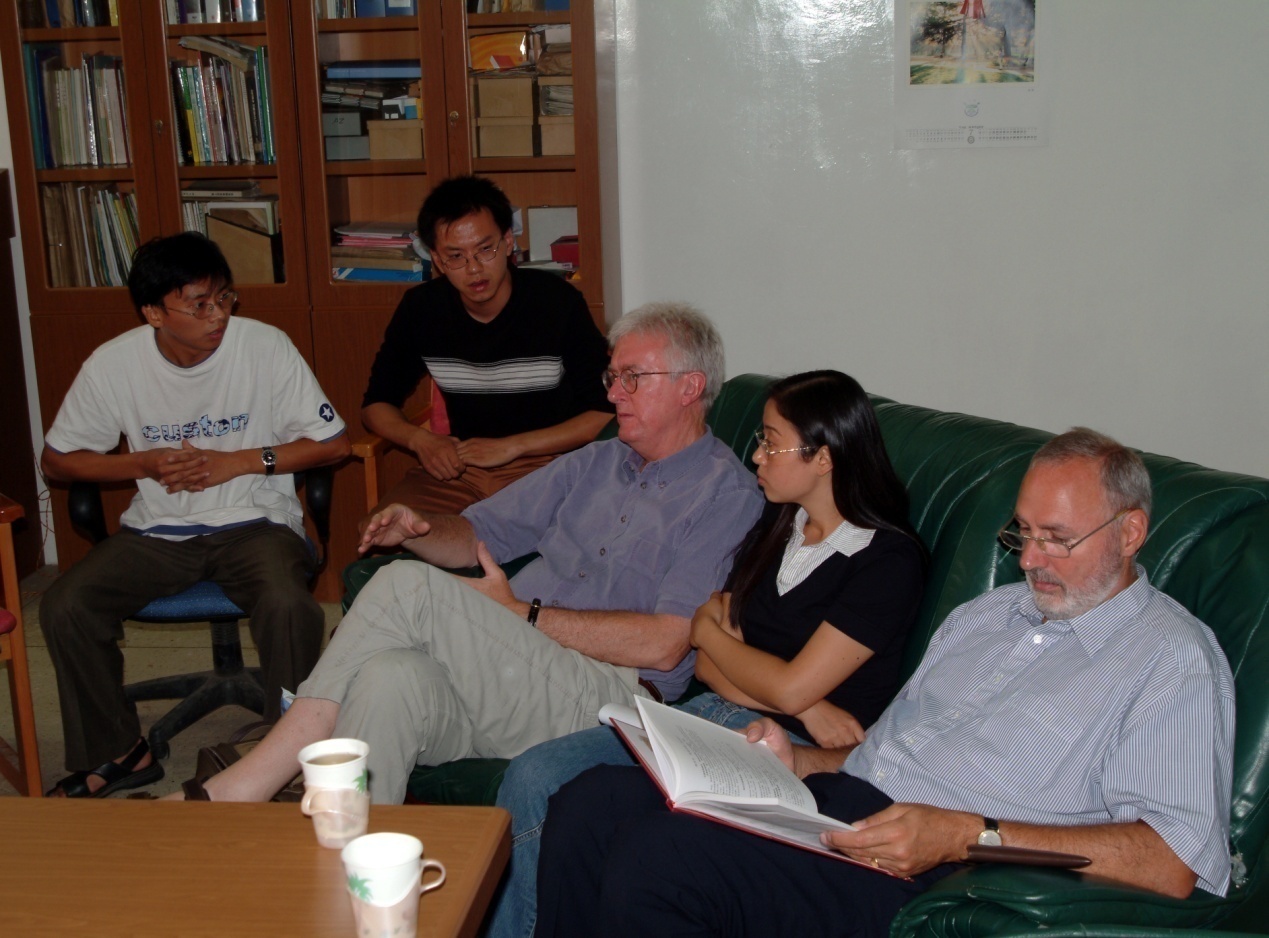
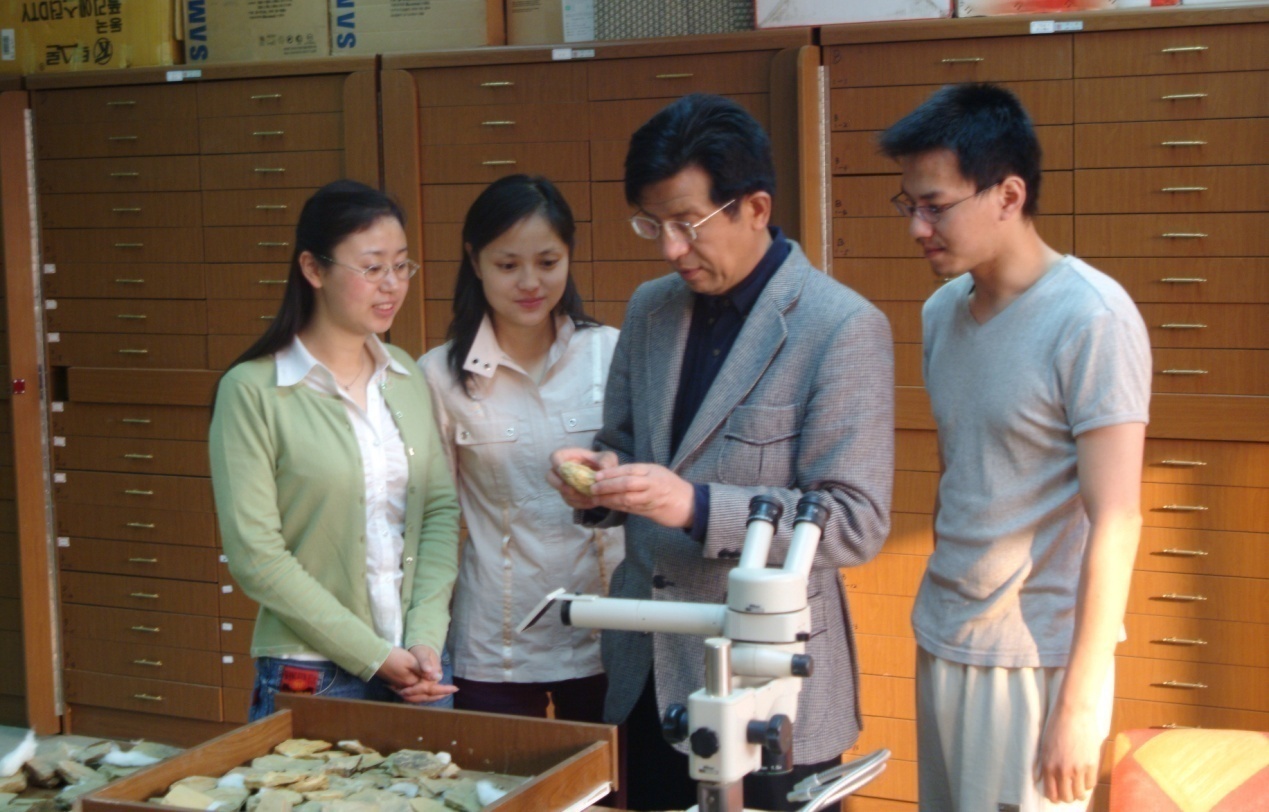
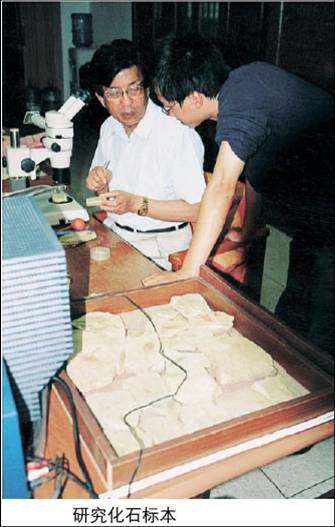
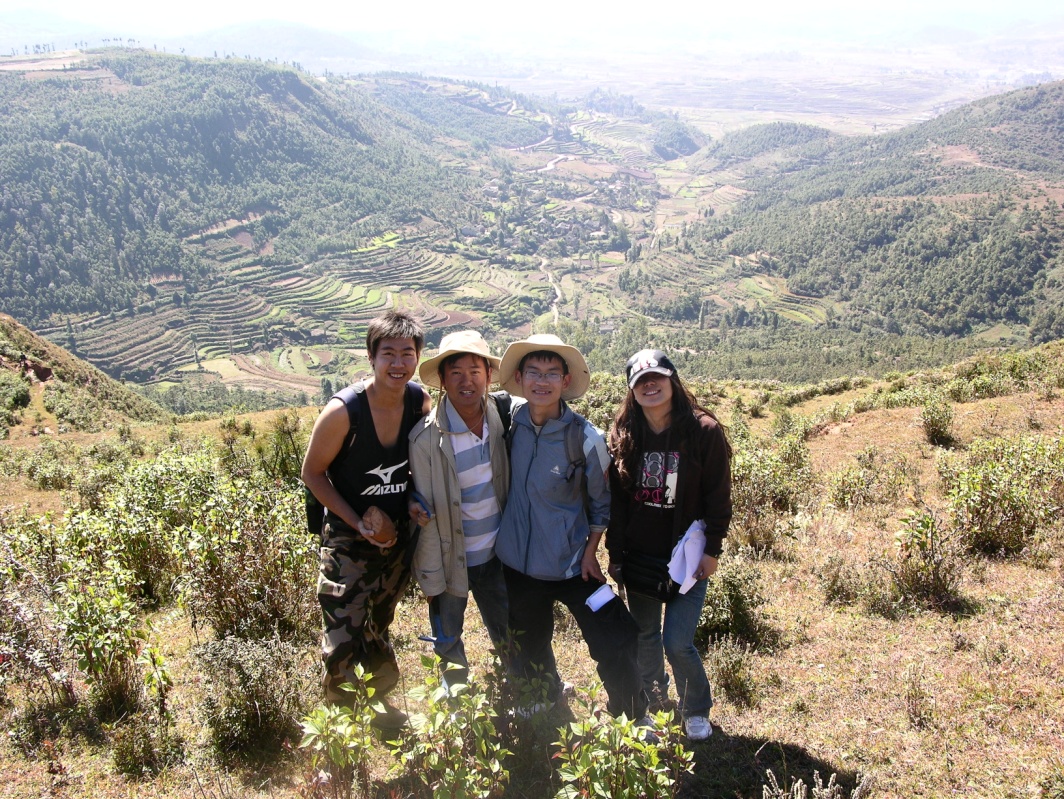
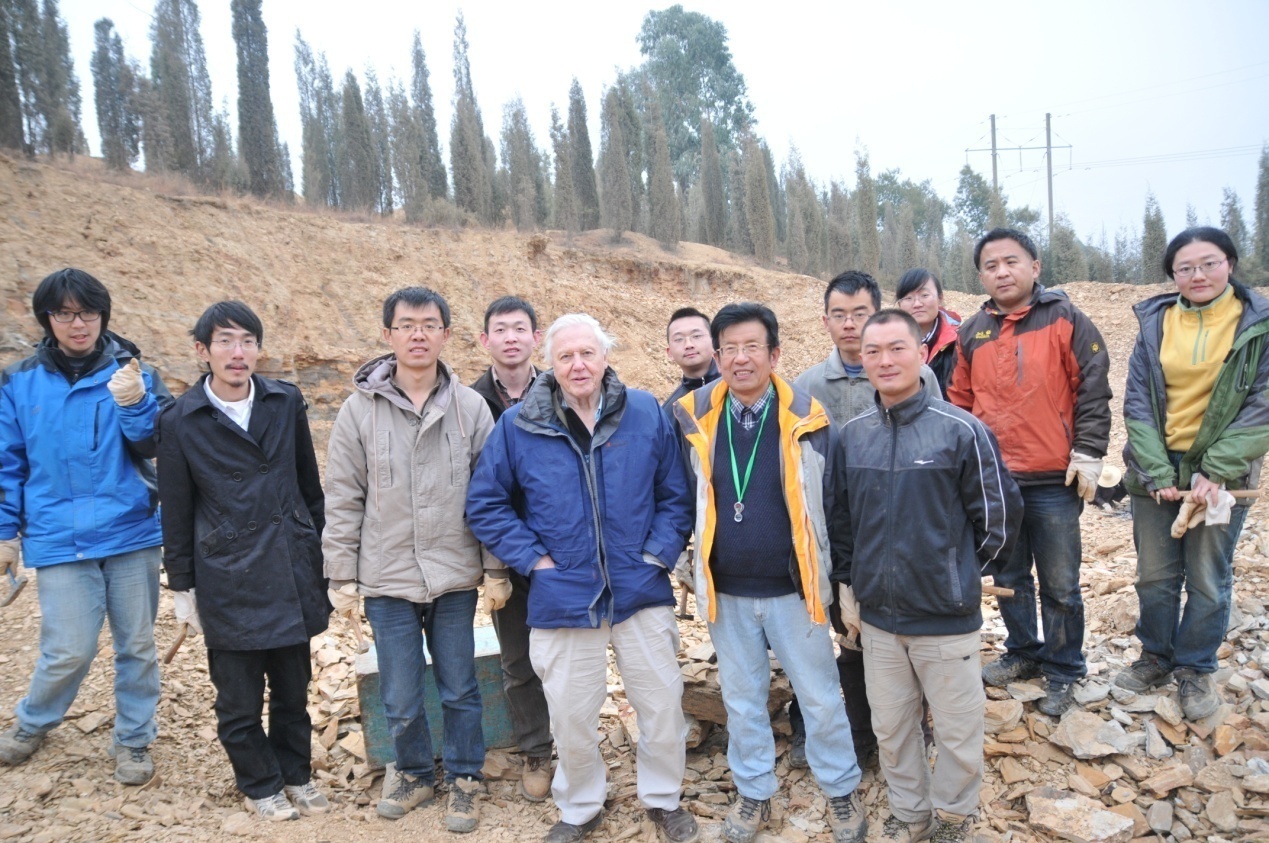
2013-1-9 BBC拍摄